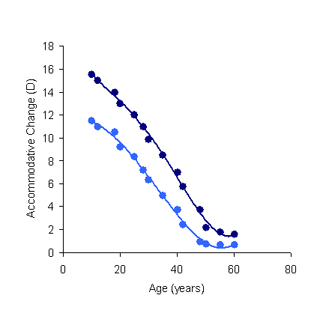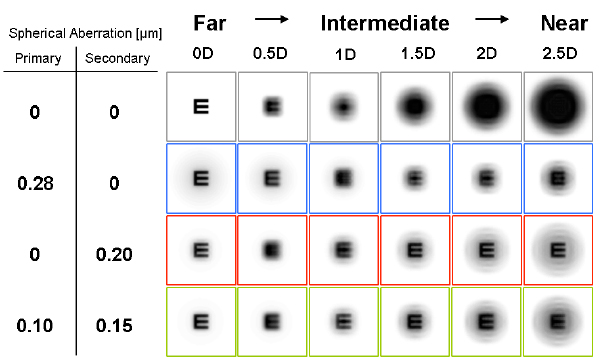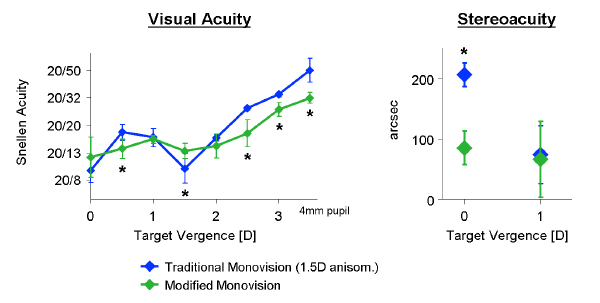
Advanced Physiological Optics Laboratory
Yoon Lab

Presbyopia originating from the Greek word presbyteros, meaning "elder", is the loss of accommodation of the human eye due to the natural aging of the lens. In the eye the natural lens grows throughout life, and recent studies suggest that the enlarging of this lens with age is the cause of its reduced pliability resulting in the inability of the lens to change shape when one looks from far to near objects. This loss of accommodative ability requires corrective optics such as glasses, contacts, refractive surgery or intraocular lenses (IOL).

Figure 1: Maximal and minimal accommodative amplitudes as a function of age measured in 1500 subjects using a "push up" technique (Duane 1912)
In the Yoon lab we are focusing on the design of new innovative IOLs for presbyopic corrections. We are using the concept of aberration interaction to design lenses that will give people depth of focus with good retinal image quality. Meaning, people will have the ability to once again see objects over a range of distances from far to near without compromising, too much, the clarity of the image that the eye sees. Below is an example of depth of focus illustrated here with a letter E. The top line shows how a person without the ability to accommodate would see this letter at different distances. The following lines illustrate the increase in depth of focus due to primary and secondary spherical aberrations.

Figure 2: A letter E as seen with out any correction (top line), and with the addition of primary and secondary spherical aberrations.
We are currently testing our designs using an optical test bench equipped with a liquid-crystal spatial light modulator (SLM). This system can generate different wavefront patterns replicating an IOLs aberrations so that preliminary tests such as visual acuity and contrast sensitivity can be done in order to predict the feasibility of the IOL design. Recently we have been looking into the interaction of primary and secondary spherical aberrations (SA) with defocus.
A binocular approach to overcoming presbyopia is to take advantage of the binocular visual system's ability to suppress the eye with poorer retinal image quality. In traditional monovision, the dominant eye is refracted for distance vision and the non-dominant eye is refracted for near vision with the addition of 1-2D of add power. The technique provides patient's with functional distance and near vision, however intermediate vision, depth perception, and binocular summation are comprimised because each eye has a relatively short depth of focus and the interocular difference in image quality is significant.
To overcome these limitations of traditional monovision, we have proposed an alternative approach called Modified Monovision. In Modified Monovision, the depth of focus of one or both eyes is increased using spherical aberration. By increasing monocular depth of focus, the interocular difference in image quality is reduced at all object distances. In a recent study (Zheleznyak et al. IOVS, 2013), we found this technique provides improved through-focus visual acuity and binocular summation. In addition, stereoacuity (i.e. depth perception) is recovered to near normal levels. The figure below shows through-focus visual acuity and stereoacuity with modified monovision and traditional monovision for comparison.

Figure 3: Depth of focus, in diopters, calculated for a 4mm pupil, with various amounts of primary and
secondary spherical aberration.
In this figure, the closed circles represent the largest vsOTF (image quality) values. This is overlaid with the variable depth of focus (solid black - primary SA, solid gray - secondary SA). This illustrates the trade off between extended depth of focus and reduction of the overall image quality. We are further testing this concept to evaluate the optimal magnitudes and higher spherical aberration orders to correct for presbyopic eyes.